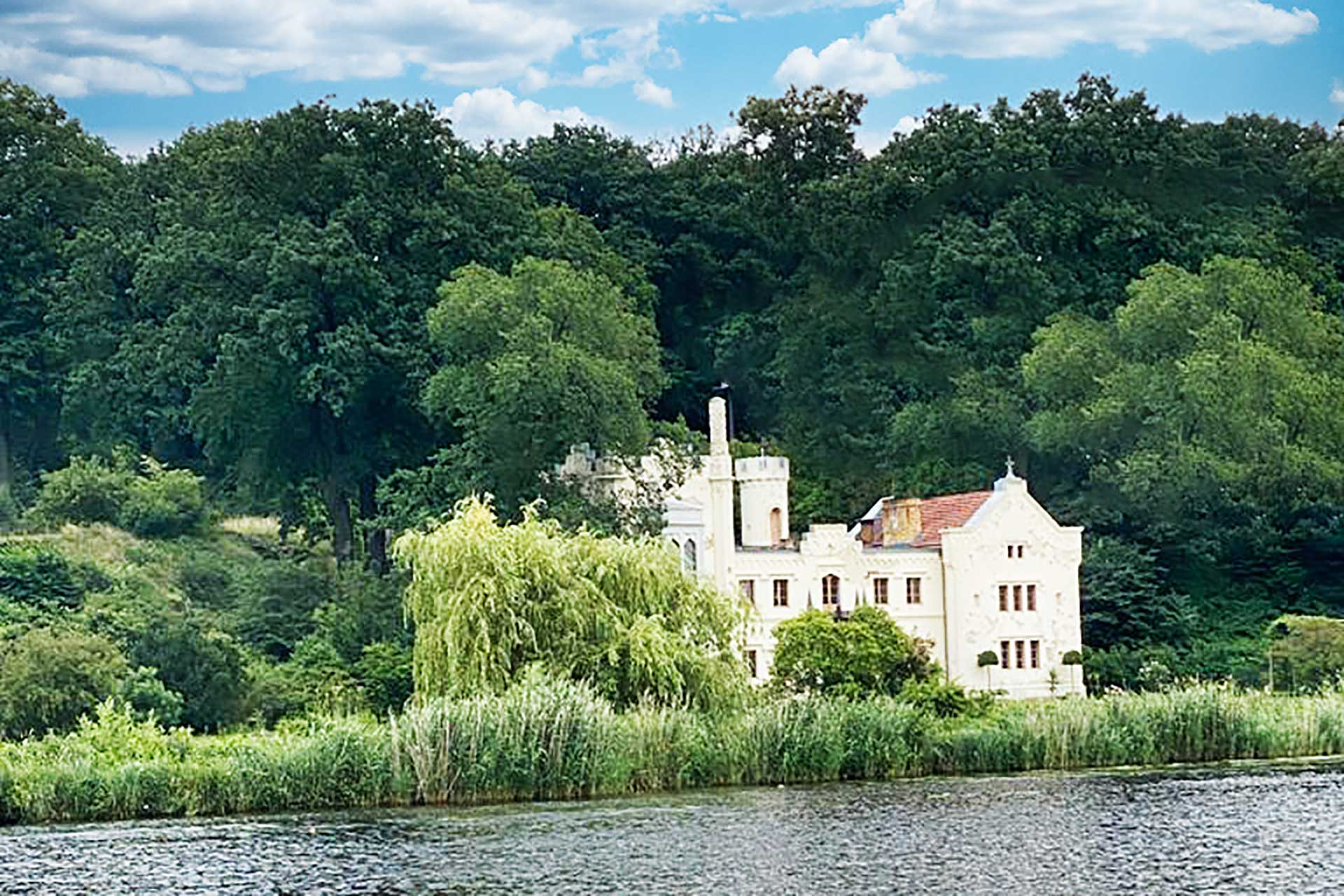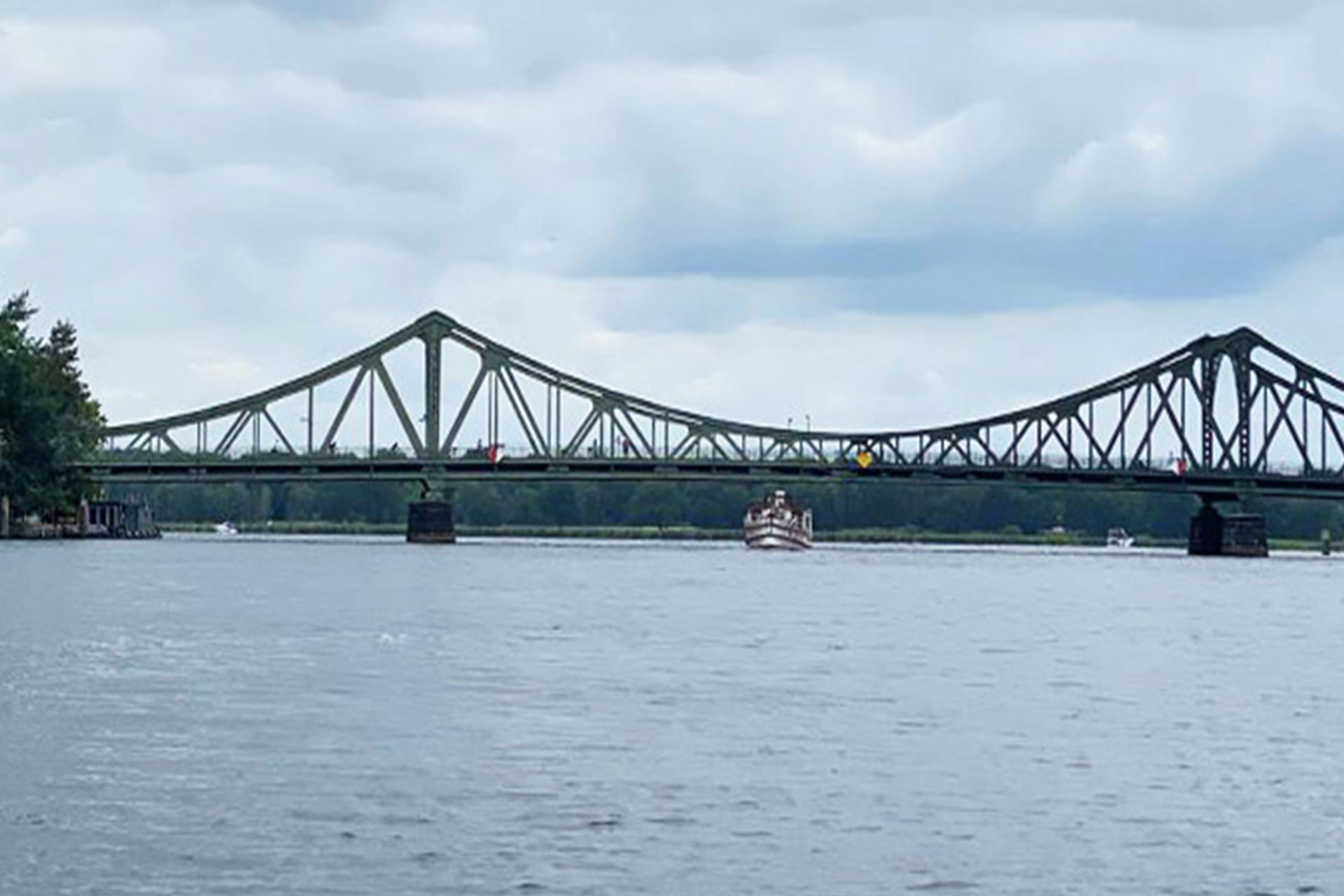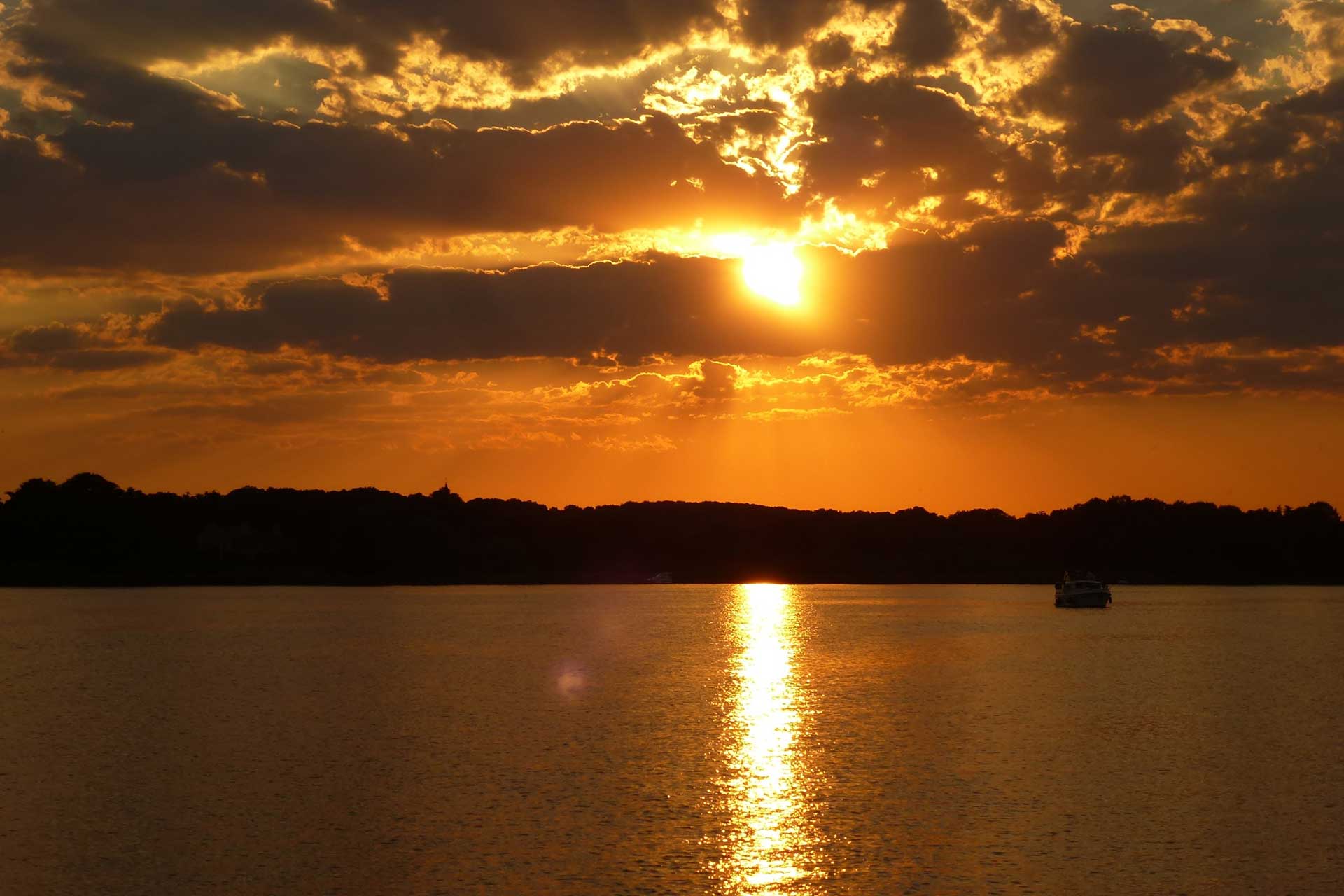Enjoy active recreation while hiking, cycling and doing water sports or explore the picturesque village of Ferch with its interesting, ever-changing exhibitions.
Leave everyday life behind you
Our house offers you excellent opportunities to explore the wonderful surroundings around the holiday paradise of Lake Schwielowsee. Directly in front of the house is a steamer landing stage of the “White Fleet” and only a few minutes away from us is a bicycle and boat rental.
Our own motor yacht, boat mooring and the lakeside path suitable for cyclists also invite you to organise your stay according to your own needs.
There is no room for boredom here!

Panorama bridge
Linger on the Panorama Pier, which is located in the immediate vicinity of our hotel. Enjoy the view of nature and water from here and watch the hustle and bustle around the boats and the steam landing stage.
Charter boat
Have you always wanted to steer a boat and go on a relaxed holiday? You don’t have a driving licence? That’s no problem with us, we also rent out our motorboat to guests without a sports boat licence.
– Deposit 250 €
– 4 hours 199 € including petrol
– 8 hours 299 € including petrol
The region of Schwielowsee
Lake Schwielowsee, just outside Potsdam, has long since ceased to be an insider’s tip for water sports enthusiasts and nature lovers. The four communities of Caputh, Ferch, Geltow and Petzow nestle on its shores, each an idyll in its own right and an ideal destination for an excursion.
Boatmen and fruit growers have written history in Caputh. Berliners and Potsdamers already appreciated the region around 100 years ago, the centre of which is Caputh Castle and its park. It was built in 1662 in the style of the Brandenburg Early Baroque and extended in 1671. Albert Einstein’s summer house also has a special flair. From 1929 to 1932, he lived here with his family from spring to late autumn and was able to concentrate on his work and also relax by hiking and sailing. The boats of the “Weiße Flotte Potsdam” (Potsdam White Fleet) set off from the landing stages, e.g. at the Caputher Gemünde and at the castle, for trips on the Havel and the Schwielowsee. Every year, in a balmy summer breeze, the events of the “Caputher Musiken” can be enjoyed in the castle and church as well as in the garden of the Einstein House.
At the southern end of Lake Schwielowsee you reach the idyllic painter’s village of Ferch, which attracts visitors with its thatched half-timbered houses, the 17th-century fishermen’s church and the “Havelländische Malerkolonie”. The Kulturforum Schwielowsee organises events such as concerts, lectures and exhibitions in the villages. There are also two landing stages for the White Fleet.
On the western shore you reach the small village of Petzow with its castle, Lenné’s Park and the Schinkel Church with its magnificent panoramic view.
On the other side of the estuary is Geltow with its Wildpark West district. The brick church in neo-Gothic style, visible from afar, greets you. Nearby, it is worth visiting the active and traditional handloom museum with looms that are over 300 years old. The “Brühl terraces” Baumgartenbrück, named after Fontane, picturesquely situated on Lake Schwielow, as well as the lido Caputh with its romantic sunsets, invite you to linger.
Only a few kilometres away is the famous blossom town of Werder (Havel), which hosts one of Germany’s largest folk festivals every year, the Baumblütenfest. Germany’s northernmost wine-growing region is also located here.
The region can be reached from Berlin via Potsdam.
One of the 30 most beautiful destinations in Brandenburg is the Japanese Bonsai Garden in Ferch.
Cycling
Along the banks, beautiful cycle routes such as the Havel Cycle Path or the R1 European Cycle Path invite you to explore by bike. They largely lead along separate and asphalted paths. Leisurely hiking trails lead around Lake Schwielow. Numerous cultural sights, cafés and restaurants as well as cycle- and family-friendly accommodation along the routes leave nothing to be desired even for a longer excursion.
Cycling and hiking trails
Our guests who are travelling without a bike can rent bicycles from the Mies family at the neighbouring Neue Scheune campsite.


Potsdam’s places of interest
The state capital Potsdam is embedded in a unique cultural landscape and has many interesting sights to offer.
Let yourself be enchanted by castles, parks, gardens and city districts…
 Sehen Sie ein historisches Vermächtnis als Residenzstadt Preußens mit den einzigartigen Schlösser- und Parkanlagen. Reizvolle Details und überraschende Einblicke lassen einen Besuch im Park auf 290 Hektar zum Erlebnis werden. Das Schloss Sanssouci ist eines der vielen Höhepunkte und Namensgeber für den Park.
Sehen Sie ein historisches Vermächtnis als Residenzstadt Preußens mit den einzigartigen Schlösser- und Parkanlagen. Reizvolle Details und überraschende Einblicke lassen einen Besuch im Park auf 290 Hektar zum Erlebnis werden. Das Schloss Sanssouci ist eines der vielen Höhepunkte und Namensgeber für den Park.
 Zu Repräsentationszwecken gedacht, sollte das Neue Palais nach dem Siebenjährigen Krieg beweisen, dass man im Königshaus noch über monetäre Mittel verfügte. Das Schloss ist am westlichen Ende der Hauptallee im Schlosspark Sanssouci zu finden und stellt eines der pompösesten Bauwerke Potsdams dar. Auch die Innenausstattung der über 170 Säle zeugt von Prunk und Wohlstand. Sogar ein kleines Theater hat der Kulturliebhaber Friedrich der Große im Innern errichten lassen.
Zu Repräsentationszwecken gedacht, sollte das Neue Palais nach dem Siebenjährigen Krieg beweisen, dass man im Königshaus noch über monetäre Mittel verfügte. Das Schloss ist am westlichen Ende der Hauptallee im Schlosspark Sanssouci zu finden und stellt eines der pompösesten Bauwerke Potsdams dar. Auch die Innenausstattung der über 170 Säle zeugt von Prunk und Wohlstand. Sogar ein kleines Theater hat der Kulturliebhaber Friedrich der Große im Innern errichten lassen.
 Das Schloss Cecilienhof ist ein geschichtsträchtiger Ort, an dem sich viele besondere Ereignisse abgespielt haben. Vor allem fand dort im Jahr 1945 die Potsdamer Konferenz statt, bei der das Potsdamer Abkommen geschlossen wurde. Heute gibt es dort eine Dauerausstellung zum Thema zu sehen.
Das Schloss Cecilienhof ist ein geschichtsträchtiger Ort, an dem sich viele besondere Ereignisse abgespielt haben. Vor allem fand dort im Jahr 1945 die Potsdamer Konferenz statt, bei der das Potsdamer Abkommen geschlossen wurde. Heute gibt es dort eine Dauerausstellung zum Thema zu sehen.
 In der Meierei lernen Sie das Biervergnügen im ganz ursprünglichen Sinne kennen. Besonders betont wird die regionale Eigenheit und jahrhundertalte Brau-Tradition. Mit einer Voranmeldung hat man sogar die Möglichkeit an einer Brauereiführung oder einem Bierseminar teilzunehmen.
In der Meierei lernen Sie das Biervergnügen im ganz ursprünglichen Sinne kennen. Besonders betont wird die regionale Eigenheit und jahrhundertalte Brau-Tradition. Mit einer Voranmeldung hat man sogar die Möglichkeit an einer Brauereiführung oder einem Bierseminar teilzunehmen.
 Das Brandenburger Tor befindet sich am westlichen Ende der Brandenburger Straße, der Einkaufsstraße Potsdams. An der Errichtung des Tores, welches einem römischen Triumphbogen ähnelt, waren zwei Baumeister beteiligt. Der im Jahr 2000 neu gestaltete Luisenplatz vor dem Brandenburg Tor lädt mit seiner Springbrunnenanlage zum Pausieren ein.
Das Brandenburger Tor befindet sich am westlichen Ende der Brandenburger Straße, der Einkaufsstraße Potsdams. An der Errichtung des Tores, welches einem römischen Triumphbogen ähnelt, waren zwei Baumeister beteiligt. Der im Jahr 2000 neu gestaltete Luisenplatz vor dem Brandenburg Tor lädt mit seiner Springbrunnenanlage zum Pausieren ein.
 Atemberaubende Aussicht, die begeistert! Das Belvedere – eine Doppelturmanlage mit großzügigen Kolonnaden im Stil einer italienischen Renaissance-Villa und umgeben von einem englischen Landschaftsgarten, ist immer wieder ein lohnenswertes Ziel. Mit einem fantastischen Blick über das Potsdamer Gartenreich wird der Marsch nach oben belohnt.
Atemberaubende Aussicht, die begeistert! Das Belvedere – eine Doppelturmanlage mit großzügigen Kolonnaden im Stil einer italienischen Renaissance-Villa und umgeben von einem englischen Landschaftsgarten, ist immer wieder ein lohnenswertes Ziel. Mit einem fantastischen Blick über das Potsdamer Gartenreich wird der Marsch nach oben belohnt.
 Im Osten der Stadt Potsdam befindet sich das Schloss Babelsberg, welches von Schinkel im neogotischen Stil entworfen wurde. Über die Jahre wirkten viele Architekten an der Gestaltung des Schlosses, welches ab 1871 Wilhelm I. als Sommersitz diente. Nach der Planung von Peter Joseph Lenné und von Fürst Pückler-Muskau wurde der Park Babelsberg nach dem Vorbild eines englischen Landschaftsgartens angelegt. Von hier bietet sich ein einmaliger Blick auf die Glienicker Brücke.
Im Osten der Stadt Potsdam befindet sich das Schloss Babelsberg, welches von Schinkel im neogotischen Stil entworfen wurde. Über die Jahre wirkten viele Architekten an der Gestaltung des Schlosses, welches ab 1871 Wilhelm I. als Sommersitz diente. Nach der Planung von Peter Joseph Lenné und von Fürst Pückler-Muskau wurde der Park Babelsberg nach dem Vorbild eines englischen Landschaftsgartens angelegt. Von hier bietet sich ein einmaliger Blick auf die Glienicker Brücke.
 Die malerischen Häuser im holländischen Stil mit vielen kleinen Restaurants, Cafés und Läden sind ein idealer Ort zum Flanieren mit besonderem Flair. Das Holländische Viertel wurde zwischen 1734 und 1742 im Auftrag des Soldatenkönigs Friedrich Wilhelm I erbaut. Sein Ziel war es, holländische Handwerker nach Potsdam zu holen und ihnen hier eine Heimat zu bieten.
Die malerischen Häuser im holländischen Stil mit vielen kleinen Restaurants, Cafés und Läden sind ein idealer Ort zum Flanieren mit besonderem Flair. Das Holländische Viertel wurde zwischen 1734 und 1742 im Auftrag des Soldatenkönigs Friedrich Wilhelm I erbaut. Sein Ziel war es, holländische Handwerker nach Potsdam zu holen und ihnen hier eine Heimat zu bieten.
 Ein weiteres sehr beliebtes Ausflugsziel ist das Krongut Bornstedt, unweit des Park Sanssouci’s. Ursprünglich als Mustergut der Hohenzollern-Familie errichtet, bietet das Haus heute viel Platz für verschiedenste Veranstaltungen. Ein besonderer Höhepunkt auf dem Krongut sind auch die „Lange Kerls“, Männer in Gardeanzügen mit einer Größe über 1,88 Meter, die sich als „lebendiges Museum“ darstellen.
Ein weiteres sehr beliebtes Ausflugsziel ist das Krongut Bornstedt, unweit des Park Sanssouci’s. Ursprünglich als Mustergut der Hohenzollern-Familie errichtet, bietet das Haus heute viel Platz für verschiedenste Veranstaltungen. Ein besonderer Höhepunkt auf dem Krongut sind auch die „Lange Kerls“, Männer in Gardeanzügen mit einer Größe über 1,88 Meter, die sich als „lebendiges Museum“ darstellen.
 Erleben Sie eine einzigartige Zeitreise durch die Brandenburger Filmgeschichte und entdecken Sie zahlreiche originale Kostüme und Requisiten. Erfahren Sie ein Stück Geschichte und Wissenswertes und lassen Sie sich zu der ein oder anderen Mitmachaktion überreden.
Erleben Sie eine einzigartige Zeitreise durch die Brandenburger Filmgeschichte und entdecken Sie zahlreiche originale Kostüme und Requisiten. Erfahren Sie ein Stück Geschichte und Wissenswertes und lassen Sie sich zu der ein oder anderen Mitmachaktion überreden.





















